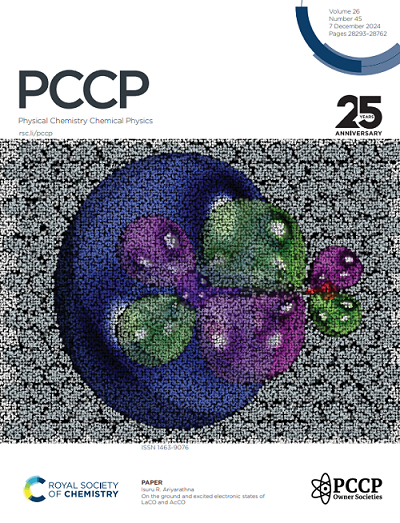Absorption properties of boron nitride quantum dots: Effects of solvents
IF 2.9
3区 化学
Q3 CHEMISTRY, PHYSICAL
引用次数: 0
Abstract
Boron nitride quantum dots combine several unique properties, including chemical stability, biocompatibility, and low cytotoxicity. These properties and tunable optical characteristics make them promising for the use in boron neutron capture therapy simultaneously as therapeutic agents and fluorescent markers for cancer cells. In this paper we present a case study, in which the electronic structure of these dots are analyzed within the DFT and TD-DFT methods providing a deeper understanding of the their absorption properties. Our approach enables an assessment of the overall effect of solvents on the absorption properties of these dots obtained by the solvothermal method. We show that solvents being medium for synthesis of quantum dots, actively participate in the formation of their absorption properties. It is demonstrated theoretically and experimentally that the change in optical properties is caused by the direct attachment of solvent molecules to the quantum dot surface.氮化硼量子点的吸收特性:溶剂的影响
氮化硼量子点结合了几种独特的特性,包括化学稳定性、生物相容性和低细胞毒性。这些特性和可调谐的光学特性使它们在硼中子捕获治疗中同时作为治疗剂和癌细胞的荧光标记物而有前景。在本文中,我们提出了一个案例研究,其中在DFT和TD-DFT方法中分析了这些点的电子结构,从而更深入地了解了它们的吸收特性。我们的方法能够评估溶剂对溶剂热法获得的这些点的吸收特性的总体影响。我们发现溶剂作为合成量子点的介质,积极地参与了量子点吸收特性的形成。理论和实验证明,溶剂分子直接附着在量子点表面是导致量子点光学性质变化的原因。
本文章由计算机程序翻译,如有差异,请以英文原文为准。
求助全文
约1分钟内获得全文
求助全文
来源期刊

Physical Chemistry Chemical Physics
化学-物理:原子、分子和化学物理
CiteScore
5.50
自引率
9.10%
发文量
2675
审稿时长
2.0 months
期刊介绍:
Physical Chemistry Chemical Physics (PCCP) is an international journal co-owned by 19 physical chemistry and physics societies from around the world. This journal publishes original, cutting-edge research in physical chemistry, chemical physics and biophysical chemistry. To be suitable for publication in PCCP, articles must include significant innovation and/or insight into physical chemistry; this is the most important criterion that reviewers and Editors will judge against when evaluating submissions.
The journal has a broad scope and welcomes contributions spanning experiment, theory, computation and data science. Topical coverage includes spectroscopy, dynamics, kinetics, statistical mechanics, thermodynamics, electrochemistry, catalysis, surface science, quantum mechanics, quantum computing and machine learning. Interdisciplinary research areas such as polymers and soft matter, materials, nanoscience, energy, surfaces/interfaces, and biophysical chemistry are welcomed if they demonstrate significant innovation and/or insight into physical chemistry. Joined experimental/theoretical studies are particularly appreciated when complementary and based on up-to-date approaches.
 求助内容:
求助内容: 应助结果提醒方式:
应助结果提醒方式:


